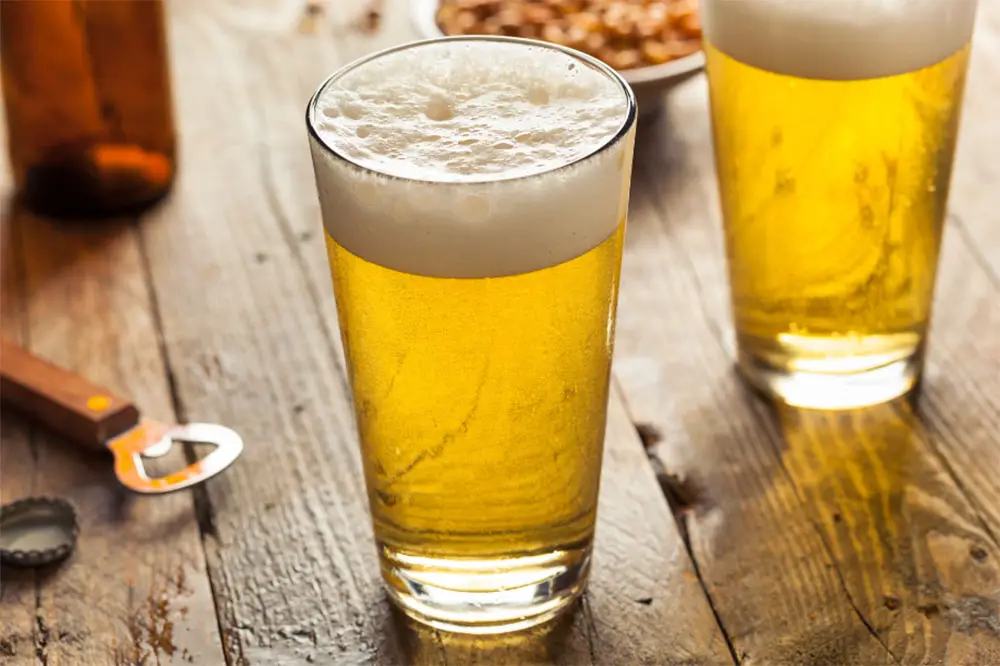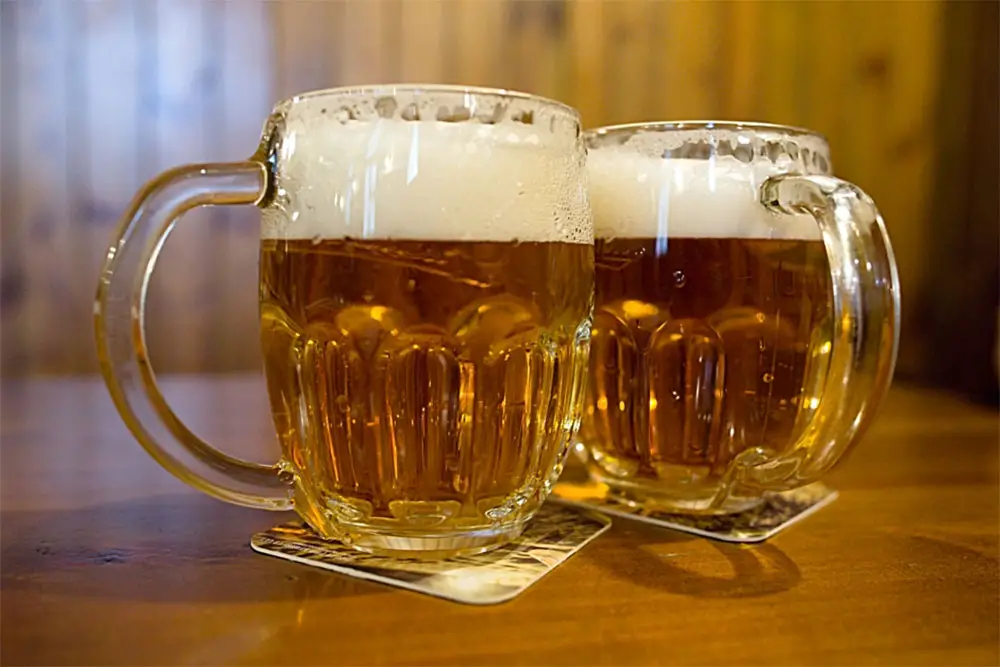For beer lovers, the single biggest challenge in the beer and homebrewing industry is recognizing and appreciating the subtle distinctions between different styles of beer.
This is particularly apparent when comparing pilsners and lager as they often exhibit many of the same qualities and characteristics.
The main distinguishing feature between the two is that pilsners have more aggressive hops and use a different type of yeast. This makes them spicier, as well as more of a hop-flavored lager.
Throughout this guide, we’ll take a closer look at all of the differences between pilsners and lager. We’ve also got answers to some of the most frequently asked questions surrounding these two beverages.
What Is A Lager?
The word “lager” is German by nature, and essentially translates to “to store”. Interestingly, lagers are the second most popular type of beer in the entire world, coming second to ales.

BEER DROP: Boxes of beer from Award-winning microbreweries → Join The Club
For added context, the origin of “lager” as a word mainly derives from a method many German brewers used in the 1800s, which included lengthy fermentation and extended periods of storage.
They would typically dig out cellars and top them completely up with ice from rivers and lakes nearby. This setup would be vital in keeping the beer nice and cool – especially during the warm summer months – and was ideal for the fermentation and aging process of lagers.
Obviously, in more recent times, brewing lagers is significantly easier with advanced refrigeration allowing you to have full control over the specific temperature conditions.
Despite this, lager is still considered one of the most difficult beer styles to master in the homebrewing industry. This is because it requires a lot of very precise conditions in terms of aging times and temperature.
The cool temperatures utilized in the fermentation of lagers helps the yeast to consume the sugar at a slower rate. This, in turn, gives the alcoholic beverage a cleaner and crisper flavor.
Lagers also take considerably longer than most other beer types to ferment, using a bottom-fermenting method.
Types Of Lager
Generally speaking, lagers are divided into two main categories: pale lager and dark lager. These two categories also have a number of sub-categories, with pale lager having helles, bock, and pilsner, while dark lager has dunkel, schwarzbier, and doppelbock.
You may recognize that we’ve included pilsner as a sub-category, but we’ll explain that a little bit later in this guide.
The most common type of lager produced across the world is the pale lager category. This style of lager usually provides a mild and welcoming flavor, and is recommended to be served cold – as opposed to a number of craft beers that are best consumed at room temperature.
The brewing of pale lagers was first introduced roughly around the 1850s when pale ale brewing techniques were brought back to Germany and brewers started to experiment with their own specific brewing methods for lager.
Until the introduction of these new techniques of brewing lagers, the vast majority of lagers remained dark in color. Darker lagers are generally less focused on the hoppy flavor associated with their pale counterparts, instead adopting a more robust and bitter taste.
As the name suggests, they usually exhibit extremely dark colors, with the brightest dark lager you’ll find being an amber/reddish color.
A few examples of some of the most prominent lager brands in the world include: Heineken, Corona, Budweiser, Pilsner Urquell, and Carlsberg. There are a wide variety of other equally popular brands, but these examples are just a few of the most famous.
What Exactly Is A Pilsner?
As you learned earlier, pilsner is a variety of pale lager. We’ve already touched upon how the particular method of brewing pale lagers was first introduced, but there’s a little more history to take note of when it comes to the pilsner style of pale lagers.
Pilsen, a city in the Czech Republic, began brewing the popular beverage as early as 1295. Their beers, however, were considerably worse than the beers produced by prominent German brewers.

In 1839, the officials of Pilsen formed a city-owned brewery which changed everything. This brewery would later go on to become “Pilsner Urquell” – one of the most prominent brands of beer in today’s industry.
The Czech brewery discovered that German brewers had begun to adopt a method of cold fermentation which helped to significantly improve the quality and longevity of their beers.
Armed with this knowledge, the Pilsen brewery hired a Bavarian brewer named Josef Groll who carried some unique new methods and ingredients with him.
Groll then used his superior knowledge to combine his brighter malts with Pilsen’s excellent water and local hops to produce a stunning golden beer with a delicious taste. This beer would go on to become the “pilsner”.
The rise of the pilsner was assisted by the fact that, during the same period of time, the price of glass manufacturing across Europe dropped substantially.
This enabled pretty much every local tavern and household to provide clear beer glasses, further displaying the unique beauty of this new golden pilsner.
Best Way To Drink A Pilsner
Most seasoned beer drinkers believe that pilsners taste better when poured into a pilsner glass. This is because these specially-designed glasses are taller and have a wide mouth to help retain the foam head and emphasize the unique and complex pilsner flavors and aromas.
The ideal serving temperature for a pilsner is between 5-8℃, according to Pilsner Urquell. Furthermore, if you’re looking to pair your pilsner drink with a suitable meal, it combines well with a wide variety of foods.
Some of the most popular include chicken, salmon, and salads, as well as light desserts such as lemon shortbread.
Similarities And Differences Between Pilsner And Lager
To put it as simply as possible, a pilsner is a type of lager. However, it’s a type of lager that was created a little bit later than most of the classic lagers.
Pilsners are typically very golden, light in color, and come with a large foaming. On the other hand, dark traditional lagers are very dark in color – sometimes black – and come with a smoky bitter taste and minimal foaming.
These days, pilsners are created from malted barley and are packed full of hops to give it characteristic aromas and tastes. Their strength is usually between 4.5% to 5.2% – although this does depend on the brand – and they’re widely considered one of the best easy-drinking types of beer.
Due to some of the differences between lager and pilsner, most people have no idea that the two fall into the same category. It isn’t unusual to assume that pilsners are far removed from dark lagers considering the differences in appearance and taste.
However, it’s important to remember that the respective brewing processes are very closely related. Both use cold fermentation and longer storage times to enhance the flavor and aroma of the beverage. Furthermore, this brewing process also extends its shelf life.
This is perhaps why pilsners and pale lagers are some of the most commercially brewed beers across the globe. While they may not be the easiest to produce, they last the longest, meaning that you’ll be able to store them for sustained periods of time without ever having to stress about an expiry date.
Frequently Asked Questions
Is Heineken A Lager Or A Pilsner?
Heineken is both a pilsner and a lager. As mentioned earlier, a pilsner is a subcategory of lager and has a golden color with significant foaming.
Heineken falls under both a “pilsner” and “lager” because it has a strong hop flavor and aroma, as opposed to some dark lagers which typically provide a more bitter and robust taste.
Is Pilsner Better Than Lager?
The answer to this question all depends on personal preference. There’s nothing definitive that proves one is better than the other.
If you’re a beer drink that prefers a golden, hoppy beverage then a pilsner or pale lager will be the best choice. If, however, you tend to like a darker, more bitter drink, a dark lager should be top of the list.
Is Corona A Pilsner?
Corona is a pale lager, so by definition, it’s also a pilsner. There’s some debate as to whether Corona is exactly a pilsner, but because pale lagers and pilsner are so similar, no one will question you if you refer to Corona as a pilsner.
Is Stella Artois Considered A Pilsner Or Lager?
Stella Artois is classed as a “Euro pale lager”. However, many people hold the view that it is a pilsner, so it’s completely up to you what you call it.
